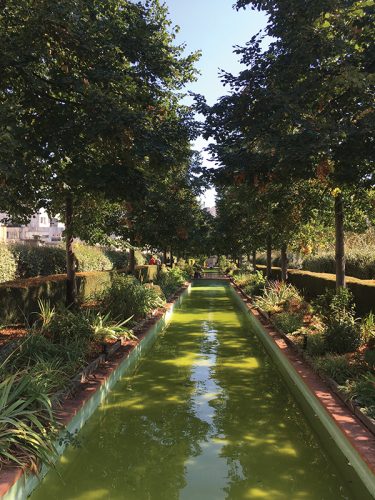By Barry Benepe
Paris is a wonder. Parisians and their guests can enjoy exceptional delight in walking along extensive networks of traffic-free arterials in the heart of the city.
First and foremost is the world famous Promenade Planteé, the model for New York City’s High Line. It runs southwest from the Place Bastille, some two miles to the Bois de Vincennes. Like the High Line, the Promenade Planteé replaced a former elevated railway. Unlike the former, this walkway is more richly landscaped, passing over massive stone arches before reaching street level and passing under roadways in three places finally terminating at the Bois de Vincennes with its inviting pastoral landscape reminiscent of the paintings of Claude Lorrain or Jean-Baptiste-Camille Corot. In the Bois, blue rowboats glide like large melon slices on the reflective surfaces of the meandering ponds.
Far fewer people are seen on the park-like Promenade than on the High Line. There is more leisure strolling, sitting, reading, even dozing. Modern buildings hug its edges, as is beginning to happen on the High Line.
A second pedestrian refuge from motor traffic is found on the edges of the Seine. Both sides are accessible to pedestrians throughout the central city, where the river can be crossed on numerous stone or steel bridges. Some are restricted to foot traffic only, such as the decorative steel lattice bridge, Pont des Arts, which visually links the great golden dome of the Institut de France with the Court Careé of the Musée de Louvre.

The massive stone embankments of the quayside slope steeply down to the Seine where great iron rings hang to secure barges and boats. The tops of the embankments are without barriers or railings of any kind. Hundreds of people sit there with legs dangling over the edge, socializing, drinking wine, eating meals, playing music.
Just as Paris led the way with the Promenade Planteé, it is once again leading by opening access to the waterfront with Paris Plage (Paris Beach), with the conversion of a waterfront highway to a park where thousands cycle, jog, stroll, and lie on sandy beaches covered by boxed palm trees twenty feet high. This began first with Sundays only, like the Central Park Drives, then expanded this year for a month from July 20th to August 21st.
Then, suddenly, to the joy of Parisians, the closure to automobile traffic of the two-lane highway on the Right Bank was extended to the end of the year with a possible permanent closing. Will New York follow again? Will West Street be narrowed to four lanes and three lanes be turned into park land? Once again, can Paris lead the way to a more walkable New York? Paris treasures its pleasures. New York should as well.
Post Script by Barry Benepe: In addition to the Promenade Planteé and Seine River walks, Paris is also friendly through its many miles of stone-paved narrow streets and squares closed to motor vehicles, including covered, sky-lit passages.
Crowning the Paris experience is the glorious bombulating of the great bells of Notre Dame, rousing the blood of our music-loving hearts—a strange eternal music that stretches back 700 years. There is both harmony and wild cacophony, rhythm and subtle off-beats.
I am told by a Parisian urban planner that human hands no longer pull the ropes that clang the clappers inside the giant bronze bells. Compressed air activates the hammers at Notre Dame and elsewhere.
However, we did watch from the sixth floor of another friend’s apartment the wild swinging of the Sunday bell in the tall cupola of L’Abbaye Gregoire, repeating a single “C” every two seconds. We could see the rope pulling it, but not who or what was pulling the rope.



